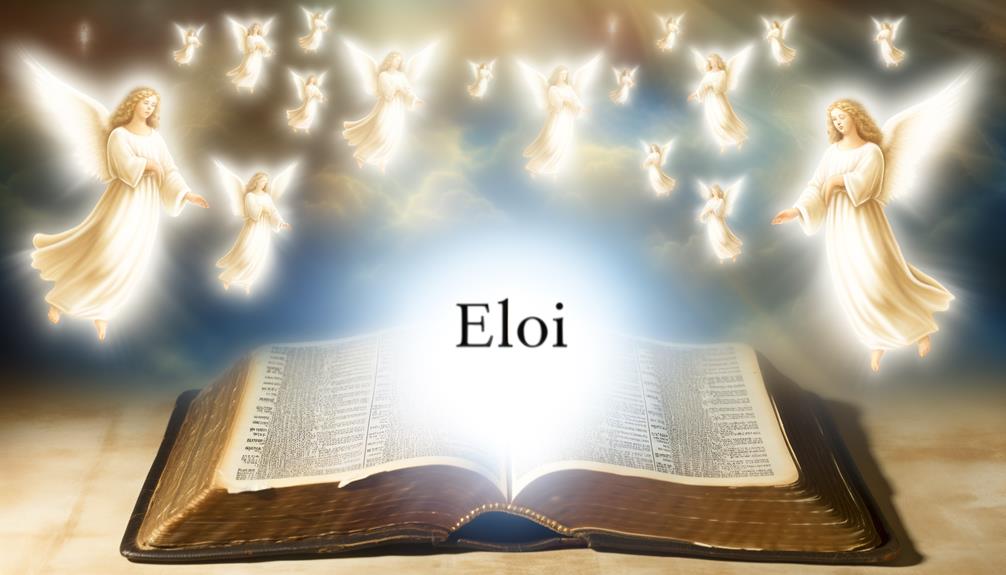Eloi Meaning In The Bible: Cry of Abandonment
In the Bible, ‘Eloi‘ appears in Mark 15:34, where Jesus Christ, during his crucifixion, cries out, ‘Eloi, Eloi, lema sabachthani?’ which means, ‘My God, my God, why have you forsaken me?’
This term, derived from Aramaic and closely related to Hebrew ‘Elohim,’ emphasizes a personal, intimate connection to God. The phrase reflects deep abandonment and fulfills the messianic prophecy of Psalm 22, linking Jesus’ suffering to Old scripture.
Jesus’ cry highlights the existential anguish and theological significance of his sacrificial act, inviting further exploration into the profound layers of meaning within this pivotal moment.

Eloi Meaning in the Bible: Jesus’ Cry and Its Deep Spiritual Message
| Aspect | Description |
|---|---|
| Word Origin | Aramaic for “My God” |
| Key Scripture | Mark 15:34 – “Eloi, Eloi, lama sabachthani?” |
| Translation | “My God, my God, why have you forsaken me?” |
| Context | Jesus’ cry from the cross during His crucifixion |
| Spiritual Meaning | Expresses deep sorrow, fulfillment of prophecy, and Jesus’ human experience |
| Prophetic Reference | Echoes Psalm 22:1, showing the connection between Old and New Testament |
The Origin of ‘Eloi’

Tracing the origin of the term ‘Eloi‘ necessitates an exploration of its linguistic roots and theological significance in biblical texts.
The term ‘Eloi’ is particularly found in the New Covenant, specifically in Mark 15:34, where Jesus Christ, in his moments of profound agony on the cross, utters, ‘Eloi, Eloi, lama sabachthani?’ This phrase, translated as ‘My God, my God, why have you forsaken me?’ bears deep theological implications.
Theologically, ‘Eloi’ is derived from the Aramaic language, reflecting Jesus’ intimate, personal address to God. This invocation underscores a profound moment of divine-human interaction, highlighting Christ’s dual nature as both divine and human, and his experience of abandonment, fulfilling Old Covenant prophecy and deepening the salvific narrative.
Linguistic Analysis of ‘Eloi’

Delving into the linguistic intricacies of ‘Eloi‘ reveals its Aramaic roots and its profound theological resonance within the context of Jesus’ crucifixion.
In Mark 15:34, Jesus utters, ‘Eloi, Eloi, lema sabachthani?’—translating to ‘My God, my God, why have you forsaken me?’ This phrase is a poignant expression of anguish, reflecting Psalm 22:1.
Linguistically, ‘Eloi’ is a possessive form of ‘El,’ meaning ‘God,’ emphasizing a personal relationship. The choice of Aramaic, the vernacular of the time, underscores Jesus’ humanity and connection to the people.
This utterance not only fulfills prophetic scripture but also encapsulates the depth of Jesus’ suffering and abandonment, resonating with believers on a deeply personal and spiritual level.
Aramaic and Hebrew Roots

The intertwined Aramaic and Hebrew roots of ‘Eloi’ illuminate its theological significance and linguistic evolution within the biblical narrative.
Aramaic, a dominant language during the Second Temple period, shares substantial lexical and grammatical features with Hebrew, the sacred language of the Jewish scriptures. ‘Eloi,’ derived from the Hebrew word ‘Elohim’ (God), reflects this linguistic synergy.
In Aramaic, ‘Eloi’ conveys the same divine reference, underscoring the term’s seamless integration into the vernacular of Jesus’ time. This intersection of languages not only reflects cultural and historical contexts but also deepens the theological resonance of the term.
Consequently, ‘Eloi’ serves as a poignant indication of the enduring interplay between sacred language and lived faith in biblical traditions.
Context in the Crucifixion

In the context of the Crucifixion, Jesus’ utterance of ‘Eloi, Eloi, lama sabachthani?’—translated as ‘My God, my God, why have you forsaken me?’—is deeply significant both theologically and scripturally.
This poignant expression not only reflects Jesus’ profound sense of abandonment but also echoes the opening verse of Psalm 22, thereby linking His suffering to the Messianic prophecy.
Such a connection underscores the fulfillment of Old Covenant scripture within the New Covenant narrative, offering a rich tapestry for theological reflection.
Jesus’ Final Words
During the crucifixion, Jesus’ final words, ‘Eloi, Eloi, lema sabachthani?’—translated as ‘My God, my God, why have you forsaken me?’—highlight a profound moment of theological significance and human anguish.
These words encapsulate the depth of Jesus’ suffering as he bore the weight of humanity’s sins. Theologically, this utterance reflects the sense of abandonment he experienced, a critical aspect in understanding the sacrificial nature of his death.
Contextually, these words are pivotal, revealing Jesus’ fulfillment of his divine mission while also expressing the raw, human experience of separation from God.
This agonizing cry underscores the gravity of the crucifixion event, inviting believers to contemplate the profound mystery of divine sacrifice and redemption.
Psalm 22 Connection
Psalm 22 serves as a prophetic backdrop to Jesus’ crucifixion, illuminating the deeper theological implications of his cry, ‘Eloi, Eloi, lema sabachthani?’
This psalm, written centuries before Christ, begins with the exact phrase uttered by Jesus, translating to ‘My God, My God, why have you forsaken me?’ It vividly describes the suffering and mockery endured, mirroring the events at Golgotha.
By invoking Psalm 22, Jesus aligns his suffering with the messianic prophecy, emphasizing his role as the suffering servant.
This connection deepens the theological understanding of his atoning sacrifice, showing that his agony was foreseen and integral to God’s salvific plan, hence fulfilling the scriptures and validating his messianic identity.
Connection to Psalm 22

The utterance ‘Eloi, Eloi, lama sabachthani?’ by Jesus on the cross directly echoes the opening verse of Psalm 22, highlighting a profound connection between the crucifixion and the psalm’s prophetic lament.
This connection underscores the theological concept of Jesus fulfilling Old Scriptures prophecy, emphasizing His role as the suffering Messiah.
Additionally, Jesus’ cry of abandonment encapsulates the depth of His human anguish and divine purpose, resonating with the themes of forsakenness and ultimate redemption found in Psalm 22.
Prophetic Fulfillment in Scripture
One of the most compelling connections between the utterance ‘Eloi, Eloi’ and prophetic fulfillment in Scripture is found in its direct correlation to the messianic prophecy articulated in Psalm 22. This Psalm portrays a suffering servant whose experiences remarkably align with Jesus’ crucifixion narrative.
The prophetic dimensions include:
- Opening Words: ‘My God, my God, why have you forsaken me?’ (Psalm 22:1).
- Mockery by Onlookers: Parallels with the mocking of Jesus on the cross.
- Physical Suffering: Descriptions of intense physical torment.
- Casting Lots for Garments: Roman soldiers casting lots for Jesus’ clothing.
These correspondences underscore a theological continuity and divine orchestration within the biblical narrative.
Jesus’ Cry of Abandonment
Jesus’ cry of abandonment, ‘Eloi, Eloi, lama sabachthani?’ intricately connects to Psalm 22:1, providing profound theological insight into his perception of divine forsakenness during the crucifixion.
This utterance, a direct quotation from the psalm, reveals Jesus’ deep identification with the suffering expressed by the psalmist.
Theologically, it underscores a moment of profound human despair and alienation, yet simultaneously affirms the fulfillment of Messianic prophecies.
Psalm 22, which begins with a cry of desolation, shifts into a declaration of trust and divine deliverance.
Consequently, Jesus’ invocation of this psalm not only highlights his human anguish but also anticipates the ensuing victory over death, offering a complex interplay between suffering and redemption.
Theological Interpretations

Scholars and theologians have long debated the profound implications of Jesus’ cry, ‘Eloi, Eloi, lama sabachthani?’ as recorded in the Gospels, exploring its theological significance within the framework of Christian soteriology and Christology.
This utterance has been interpreted in various ways, each providing a unique lens through which to view the mystery of the Incarnation and Atonement.
- Expression of Human Suffering: Highlights Jesus’ full participation in human pain and abandonment.
- Fulfillment of Prophecy: Seen as the fulfillment of Psalm 22, linking Old scripture prophecy to New scripture events.
- Divine Forsakenness: Interpreted as a momentary separation from God due to bearing humanity’s sin.
- Cry of Desperation: Reflects the depth of Jesus’ emotional anguish.
- Theological Paradox: Emphasizes the mystery of Jesus being fully God and fully man.
‘Eloi’ in the Gospels

The phrase ‘Eloi, Eloi, lama sabachthani?’ as recorded in the Gospels of Matthew and Mark, serves as a poignant focal point for understanding the multifaceted dimensions of Jesus’ crucifixion narrative.
Linguistically, ‘Eloi’ translates to ‘My God’ in Aramaic, reflecting Jesus’ intimate relationship with the Father.
Contextually, this cry from the cross, derived from Psalm 22:1, signifies a profound moment of distress and fulfillment of Old Scripture prophecy.
Theologically, it encapsulates the dual nature of Christ—fully divine and fully human—experiencing abandonment.
This utterance, consequently, is not merely a cry of despair but a deliberate invocation of scriptural fulfillment, bridging the Old Covenant with the New, and offering a deep layer of meaning to the Passion narrative.
Emotional Significance

The utterance ‘Eloi, Eloi, lama sabachthani?’ reflects a profound expression of despair, encapsulating the human experience of divine abandonment.
This cry from the cross signifies not only Jesus’ acute physical and emotional suffering but also highlights the theological depth of His sacrificial role.
Understanding this moment requires a nuanced appreciation of its emotional and spiritual dimensions within the broader narrative of redemption.
Expression of Despair
In the context of the crucifixion narrative, Jesus’ cry of ‘Eloi, Eloi, lema sabachthani?’ serves as a profound expression of existential despair and spiritual abandonment. This utterance encapsulates the depth of human suffering and isolation, reflecting several significant dimensions:
- Psychological Agony: Jesus experiences acute emotional distress.
- Theological Implication: It highlights the human aspect of Jesus’ dual nature.
- Scriptural Fulfillment: Echoes Psalm 22:1, anchoring His suffering in Jewish tradition.
- Communal Alienation: Indicates a profound sense of separation from the divine and humanity.
This cry, consequently, resonates deeply within the Christian narrative, embodying the raw human emotion in the face of divine purpose.
Divine Abandonment Cry
Jesus’ exclamation, ‘Eloi, Eloi, lema sabachthani?’, serves as a poignant articulation of divine abandonment, encapsulating profound emotional and theological dimensions.
This cry, recorded in both Matthew 27:46 and Mark 15:34, signifies a moment of intense anguish as Jesus experiences a perceived separation from God the Father.
Theologically, it reflects the weight of humanity’s sin that Jesus bore on the cross, symbolizing the ultimate sacrifice.
Emotionally, it captures the raw human experience of despair and isolation, offering a profound connection to those who suffer.
Contextually, it recalls Psalm 22:1, linking Jesus’ suffering to prophetic fulfillment.
Consequently, this exclamation becomes an essential lens through which the nature of Christ’s redemptive suffering is understood.
Scholarly Debates

Scholarly debates surrounding the meaning of ‘Eloi’ in the Bible often center on its linguistic roots, theological implications, and contextual significance within the narrative. Experts grapple with various aspects to gain a deeper understanding:
- Linguistic Origin: The term ‘Eloi’ is scrutinized for its Aramaic and Hebrew roots, exploring its exact translation and phonetic variations.
- Theological Weight: Discussions focus on the theological implications of Jesus’ cry, examining its resonance with Old scriptures.
- Contextual Placement: Scholars analyze the narrative context, considering why this term was chosen at that particular moment.
- Historical Context: The historical and cultural backdrop of the period is examined to understand its significance.
These debates enrich our comprehension of this profound biblical expression.
Modern Reflections

Modern reflections on the term ‘Eloi‘ in the Bible often focus on its enduring theological significance and its impact on contemporary faith practices.
The term, famously uttered by Jesus during His crucifixion, ‘Eloi, Eloi, lema sabachthani?’ (Mark 15:34), resonates deeply within Christian theology as it encapsulates the profound sense of abandonment and divine mystery.
Modern theologians and believers alike interpret this cry as a pivotal moment that underscores the human experience of suffering and the divine nature of redemption.
In contemporary worship and personal devotion, ‘Eloi’ serves as a poignant reminder of the intimate relationship between humanity and the divine, prompting ongoing reflection on faith, trust, and the nature of divine presence in moments of despair.
Broader Biblical Themes

The term ‘Eloi’, while deeply significant in the context of Jesus’ crucifixion, also opens a window into broader biblical themes, such as the nature of divine presence and human suffering, that permeate the entire scriptural narrative. These themes are not isolated but interwoven throughout the Bible, offering profound theological insights.
- Divine Abandonment and Presence: Jesus’ cry reflects the tension between feeling forsaken and trusting in God’s omnipresence.
- Human Suffering and Redemption: It underscores the redemptive purpose behind suffering, as exemplified by Christ.
- Fulfillment of Prophecy: This moment aligns with Old Scriptures prophecies, showcasing continuity in divine plans.
- Covenant Relationship: It highlights the depth and complexity of the covenant between God and humanity.
Conclusion
In summation, the term ‘Eloi‘ encapsulates profound theological and emotional dimensions within its utterance, particularly in the crucifixion narrative.
Rooted in Aramaic and Hebrew linguistics, it bridges Old Scripture prophecy and New Scripture fulfillment, resonating with Psalm 22’s lament.
The scholarly discourse surrounding ‘Eloi’ underscores its multifaceted significance, inviting deeper contemplation on divine desolation and human suffering.
This term’s enduring resonance continues to evoke reflection on broader biblical themes, transcending mere historical context to touch the ineffable.






